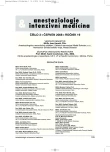Distraction osteogenesis in the head and neck region
Authors:
Koudstaal Maarten Jan 1; Rupreht Joseph 2; Van Der Wal Karel G. H. 1
Authors‘ workplace:
Department of Oral and Maxillofacial Surgery Craniofacial Center, Sophia Children’s Hospital, Erasmus University
Medical Center Rotterdam
1; Department of Anesthesiology Craniofacial Center, Sophia Children’s Hospital, Erasmus University Medical
Center Rotterdam
2
Published in:
Anest. intenziv. Med., 19, 2008, č. 3, s. 139-142
Category:
Anaesthesiology - Review Article
Overview
Distraction osteogenesis is a treatment often used in orthopedics and plastic surgery, but more frequently so in maxillofacial surgery. There is a variety of distractors available for use on the different parts of the maxillofacial skeleton. The aim of this article is to give publicity to distraction osteogenesis in the field of oral and maxillofacial surgery and to the different types of intra- and extraoral distractors frequently used in the head and neck region. The application of such distractors for several months while the patient carries on everyday life is potentially hazardous in case of an emergency. The anesthesiological aspects of these devices will be discussed in order to minimize the risks in cases of acute medical interventions.
Keywords:
distraction osteogenesis – maxillofacial surgery – anesthesiological aspects – emergency medicine
Sources
1. Codivilla, A. On the means of lengthening, in the lower limbs, the muscles and tissues which are shortened through deformity. Am. J. Orthop. Surg., 1905, 2, p. 353.
2. Ilizarov, G. A. Clinical applications of the tension-stress effect for limb lengthening. Clin. Orthop., 1990, 250, p. 8–26.
3. Mommaerts, M. Y. Transpalatal distraction as a method of maxillary expansion. Brit. J. Oral. Maxillofac. Surg., 1999, 37, p. 268–272.
Labels
Anaesthesiology, Resuscitation and Inten Intensive Care MedicineArticle was published in
Anaesthesiology and Intensive Care Medicine

2008 Issue 3
Most read in this issue
- Selective bronchial intubation with the UniventR tracheal tube in children
- A 39-year patient with a severe haemorrhagic-traumatic shock due to a gunshot, with a left-sided penetrating chest wound resulting in haemothorax, pneumothorax and massive blood loss was treated in the Czech Field Hospital ROLE 2 plus after a terrorist attack in Kabul. The initial Sequential Organ Failure Assessment (SOFA) of 13 points improved thanks to damage control surgery and adequate perioperative care to 5 points, increasing the chance of survival from 5% to 80%. The patient was transported to his homeland on the 3rd postoperative day where he recovered.
- Research in Anaesthesiology and Resuscitation in the second half of 20th Century
- Preventive measures of nosocomial infection in ventilated patients – current status
